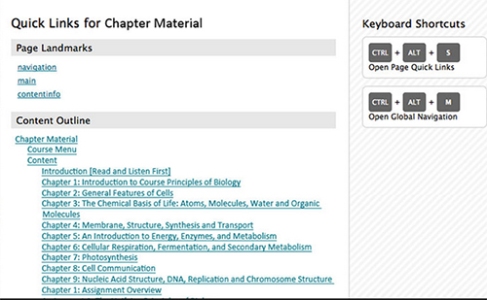Accessible Online Learning
July 10, 2013 40 Comments
Be Proactive: Creating An Accessible Online Learning Environment Using Blackboard
JoAnna Hunt, Design Strategist – Blackboard Learn
Jennifer Pope, Copy & Compliance Editor – Northeastern University
Ke’Anna Skipwith, Instructional Designer – Northeastern University
Stephanie Weeks, Vice President – User Experience, Blackboard Academic Platforms
This session highlighted how Northeastern University is being proactive in building accessible online course content; along with the latest accessibility features in Blackboard Learn and Collaborate products. An accessible LMS + accessible faculty course content = student success.
Barriers to accessibility:
- Lack of knowledge
- Lack of Time
- Challenges with the LMS
- Lack of Awareness
Biggest knowledge gaps:
Some accessibility features in Blackboard Learn:
- New accessible calendar.
- Much easier to understand and navigate the discussion boards.
- Skip links allow users to skip over major navigation sections (such as the course menu) and jump directly to the most relevant content. Skip links are available to both keyboard only and screen reader users.
- The Quick links tool allows a user to quickly locate any heading or section within any page in the Blackboard Learn application and jump directly to it.

- Test availability exceptions is a set of new settings on the Test Options page, available only after the test is added to a content area. Select one or more groups of students and make a number of exceptions to the already established availability settings. Exceptions can be used to provide an accommodation to a disabled student, or provide accommodations for technology and language differences.
Why be proactive in creating accessible online course content:
- Saves time
- Minimizes course disruption
- Reduces cost
Northeastern University’s approach:
- First step is mandatory two week training in which the instructor becomes certified.
- Second step is readiness / quality
(2×2 rule – 2weeks of course material ready 2 weeks before the course begins). - Third step is ongoing support for faculty. Instructional designers assigned to faculty members for one-on-one support.
The follow are examples of being proactive in creating universally designed and accessible online course content at Northeastern University:
- Use descriptive text and alt text.
- Use CC and/or print transcripts to benefit all students with text reinforcement.
- Use of the note section in Bb Collaborate Voice board.
- Provide text based lectures in additional formats such as a PowerPoint that has the material chunked into sections.
- Use the notes section in PowerPoints to provide additional information.
